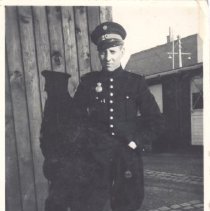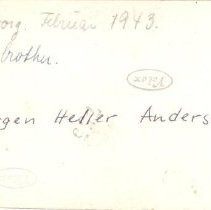Photo Record
Images


Metadata
Object Identification Number |
2006.031.001 |
Object Name |
Print, Photographic |
Donor |
Jessen, Babs |
Description |
Black and white photo of Jørgen Heller Andersen in his police uniform (see notes about the hat). He is standing at the corner of a building on a cobblestone walkway with his hands in his pockets. The uniform is dark in color and the coat buttons up the front. He has a badge on his proper right breast. The hat has a strap around the center and a badge or pin above. He is wearing tall shiny dark boots and pants that bubble out slightly at the thighs. The photo has a thin white border. Handwriting on the back reads "Aalborg. Februar 1943. / my brother. / Jørgen Heller Andersen". "Velox" is stamped in two places and "755" is stamped across the man's name. |
Print Size |
2 1/4 x 3 1/2 |
Creation Date |
February 1943 |
Place of Creation |
Denmark/Aalborg |
Associated People |
Andersen, Jørgen Heller |
Search Terms |
Andersen, Jørgen Heller Aalborg, Denmark uniform military war WWII World War II police |
Given In Memory Of |
In Memory of Jørgen Heller Andersen |
Date Received by Museum |
06/09/2006 |
Provenance |
The man in the photo is the donor's brother (we have his police cap in our collection--see 1991.157.001a). He became a police officer in 1942. This photo was taken in Aalborg. The donor said the Germans ordered the police to patrol the railroad tracks in Jylland against sabotage. Supplemental information supplied by the donor for this gift and found in the file for 1991.157, written by the donor: Jørgen Heller Andersen was born October 4th, 1919 in Frederiksberg (Copenhagen). He never visited the U.S. Before becoming a police officer he was a window-display decorator in a large department store in Copenhagen. He has three years of training. He became a police officer in the fall of 1942. He was first stationed in Aalborg. They patrolled the railway tracks, by German order, to check for sabotage. Later he went to Frederiksberg (Copenhagen) as a regular police officer. On September 29, 1944, he was picked up by the Germans, along with every police officer in Denmark, on fake pretence. Some were lucky to go underground. They were sent by freighters to Germany and then by rail in box cars. He was in Neuengamen and Buchenwald concentration camps, and then in Frøslev Camp (there the last part of March 1945 until May 2 or 3 of that year), until he was sent home on a Swedish Red Cross bus, arriving in Copenhagen May 5, 1945. A note about Frøslev--it was built in 1944 with Danish money by the Germans. It was located by the town of Padborg, 3 kilometers north of the German border. Jørgen got permission to send for his fiance that lived in Århus. On April 11, 1945, they married at the mayor's office in town. Jørgen's new wife's name was Grethe Offersen. After a short wedding ceremony at Frøslev, Grethe took the train back to Århus. He took early retirement in the summer of 1977, his health slightly deteriorated. Some years later the Danish government passed a new law giving former concentration prisoners compensation for life--he received 40,000-50,000 kroner in compensation from the German government for working in the German camp. As of August 2006, Jørgen was still living. |
Images |
079\2006031001.JPG |
Accession number |
2006.031 |
Collection |
Art / General |
